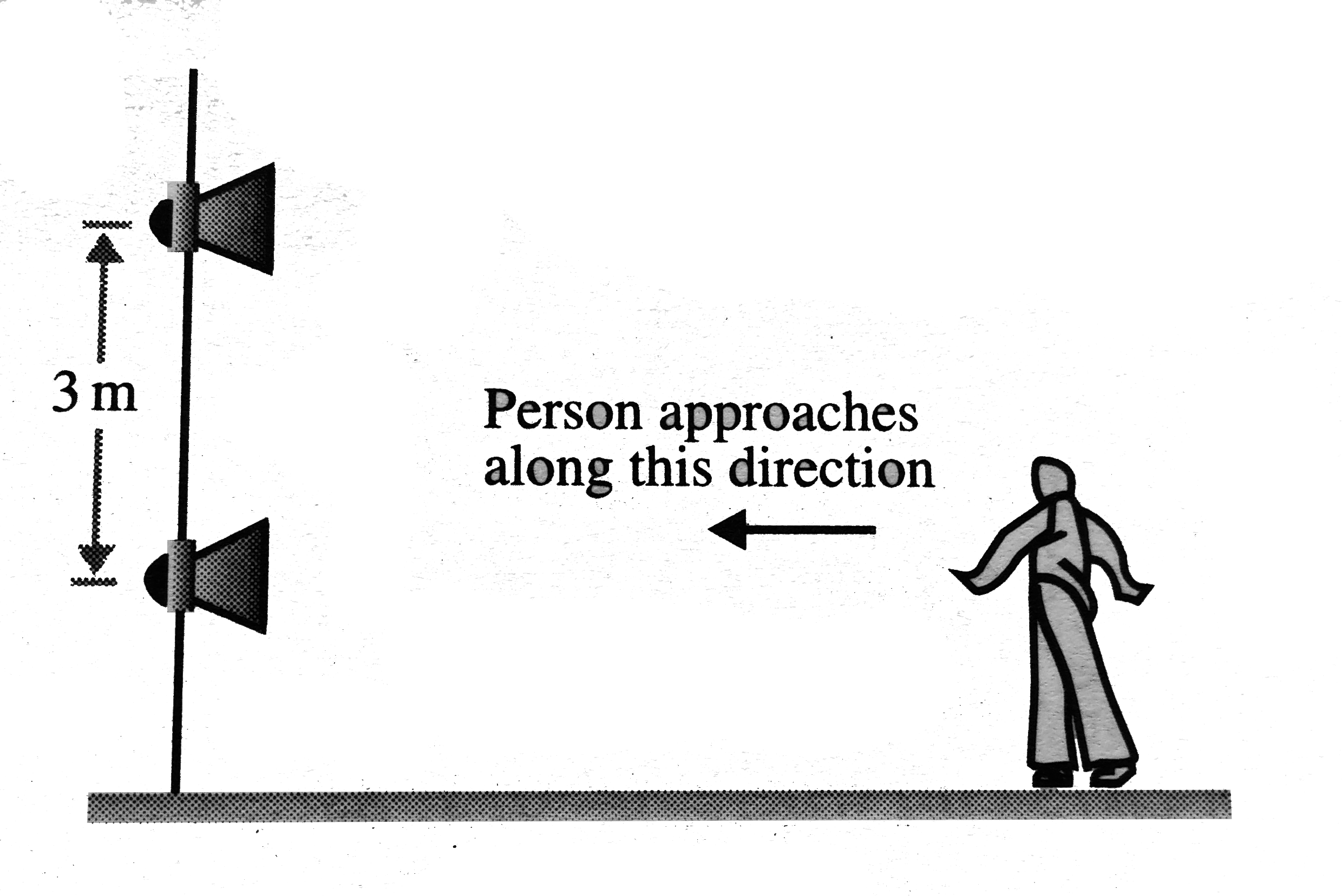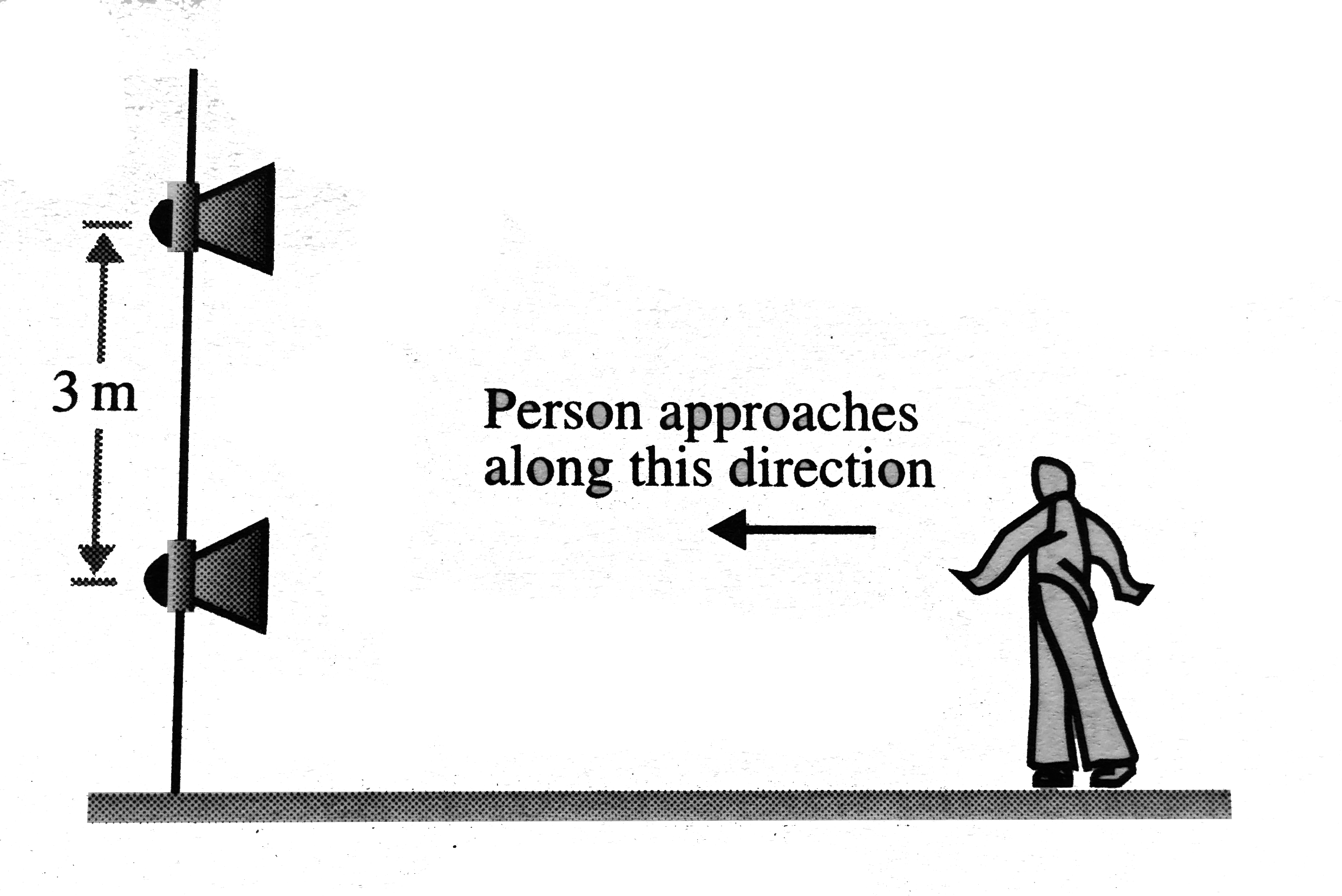An oscillator of frequency drives two speakers . The speakers are fixed on a vertical pole at a distance from each other as shown in Fig. 7.103. A person whose height is almost the same as that of the lower speaker walks towards the lower speaker in a direction perpendicular to the pole. Assuming that there is no reflection of sound from the ground and speed of sound is , answer the following questions.

At some instant , when the person is at a distance from the pole , the wave function ( at the person's location) that describes the waves coming from the lower speaker , where is the amplitude , with (given) and
Wave function ( at the person's location) that describes waves coming from the upper speaker can be expressed as :
The correct Answer is:C
When the person is at distance from pole then the path travelled by wave from .
Path differnce
As
Therefore , path difference .
Path difference of corresponds to
It can be expressed as
Topper's Solved these Questions
- SUPERPOSITION AND STANDING WAVESBOOK - CENGAGE PHYSICS ENGLISHCHAPTER - SUPERPOSITION AND STANDING WAVESEXERCISE - Integer
9 Videos
- SUPERPOSITION AND STANDING WAVESBOOK - CENGAGE PHYSICS ENGLISHCHAPTER - SUPERPOSITION AND STANDING WAVESEXERCISE - Single Correct Answer Type
56 Videos
- SUPERPOSITION AND STANDING WAVESBOOK - CENGAGE PHYSICS ENGLISHCHAPTER - SUPERPOSITION AND STANDING WAVESEXERCISE - Assertion - Reasoning
6 Videos
- SOUND WAVES AND DOPPLER EFFECTBOOK - CENGAGE PHYSICS ENGLISHCHAPTER - SOUND WAVES AND DOPPLER EFFECTEXERCISE - Integer
16 Videos
- THERMODYNAMICSBOOK - CENGAGE PHYSICS ENGLISHCHAPTER - THERMODYNAMICSEXERCISE - 24
1 Videos
Similar Questions
An oscillator of frequency 680Hz drives two speakers . The speakers are fixed on a vertical pole at a distance 3m from each other as shown in Fig. 7.103. A person whose height is almost the same as that of the lower speaker walks towards the lower speaker in a direction perpendicular to the pole. Assuming that there is no reflection of sound from the ground and speed of sound is v=340m/s , answer the following questions.

How far is the person from the pole when he hears a minimum in sound intensity a second time ?
View SolutionAn oscillator of frequency 680Hz drives two speakers . The speakers are fixed on a vertical pole at a distance 3m from each other as shown in Fig. 7.103. A person whose height is almost the same as that of the lower speaker walks towards the lower speaker in a direction perpendicular to the pole. Assuming that there is no reflection of sound from the ground and speed of sound is v=340m/s , answer the following questions.

As the person walks towards the pole , his distance from the pole when he first hears a minimum in sound intensity is nearly
View Solution
Knowledge Check
Who is the speaker of the poem, 'Birches'?
Aa man reflecting upon his boyhoodBa girl who lives in the cityCa cowDa small boy
An oscillator of frequency 680Hz drives two speakers . The speakers are fixed on a vertical pole at a distance 3m from each other as shown in Fig. 7.103. A person whose height is almost the same as that of the lower speaker walks towards the lower speaker in a direction perpendicular to the pole. Assuming that there is no reflection of sound from the ground and speed of sound is v=340m/s , answer the following questions.

As the person walks toward the pole , the total number of times that the person hears a minimum in sound intensity will be
View SolutionA loud speaker converts
View SolutionWhat is the energy conversion take place in a loud speaker?
View SolutionTwo speakers are driven by the same oscillator with frequency of 200 Hz. They are located 4 m part on a vertical pole. A man walks straight towards the lower speaker in a direction perpendicular to the pole, as shown in figure. (i) How many times will he hear a minimum in sound intensity, and (ii) how far is he from the pole and at these moments ? Take the speed of sound to be 330 m/s, and ignore any sound reflections coming off the ground.
_E01_139_Q01.png) .
.
View SolutionTwo speakers are placed as shown in Fig.7.98.
Mark out the correct statement(s)

View SolutionWith reference to the Union Legislature, answer the following questions :
How is the Speaker of the Lok Sabha elected ? State two Disciplinary Functions of the Speaker.
View SolutionLetter to the collector of your district the use of loud speaker for board exam
View Solution
